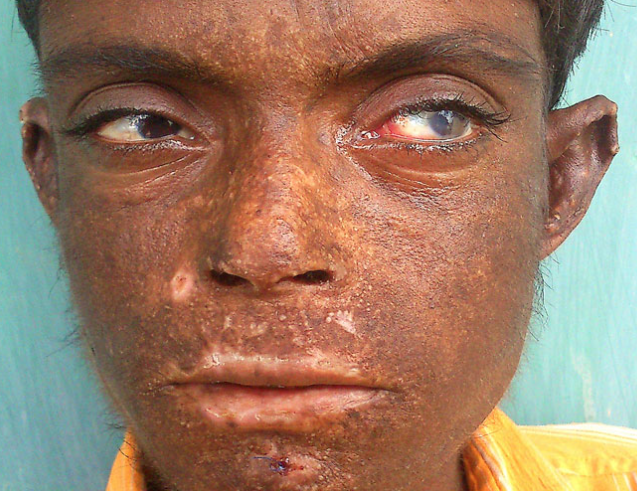Congenital erythropoietic porphyria is a rare autosomal recessive inherited photodermatosis. ICD-10 Code: E80.0
The inheritance pattern is autosomal recessive and the pathological gene is located at 10q 25.2-q26.3. The disease is characterized by a significant mutational effect of photosensitization, hemolytic anemia with splenomegaly, and a poor prognosis. The pathogenesis is based on a deficiency of uroporphyrinogen-III co-synthetase and excessive accumulation of the I isomer of uroporphyrinogen, with further difficulties in its conversion to heme.
The major deficiency of the enzyme occurs in the bone marrow, leading to overproduction of porphyrins in it. Increased hemolysis is observed with the release of a large amount of uroporphyrinogen, which oxidizes to uroporphyrin, deposits in the skin, and causes photosensitization.
The primary symptom is a high photosensitivity of the skin, resulting in redness, swelling, burning, or itching, followed by the formation of blistering lesions after brief exposure to sunlight, especially on exposed areas such as the face, neck, ears, and backs of the hands. The contents of the blisters may be serous or hemorrhagic and may become purulent after secondary infection. Deep ulcers form at the sites of ruptured blisters, leaving scars on the skin after healing. The skin becomes hyperpigmented and has a mottled appearance due to telangiectasias, milium-like elements, hypertrichosis, and depigmented spots in areas where blisters have resolved.
Due to the destruction of collagen and elastic fibers, the facial expression is reduced, giving patients a puckered appearance. Skin changes resembling morphea progress to mutilation of the finger phalanges, nose and ears. The nails become brownish and show dystrophic changes.
Within a few years, hypertrichosis of the skin of the extremities and face resembling lanugo develops, as well as scarring alopecia of the scalp and persistent brown discoloration of the teeth (which show a reddish glow under Wood's lamp). Splenomegaly is also observed.
Light-induced lesions are not limited to the skin, but also affect the eyes, causing cataract formation.
Anemia is a constant feature of congenital erythropoietic porphyria and can reach life-threatening levels. The disease, which begins in early childhood, interferes with normal physical and intellectual development, and patients usually do not survive into old age.
Diagnosis is based on clinical presentation and laboratory findings. Urine shows elevated levels of uroporphyrin (20-60 times higher than normal), with a lesser accumulation of coproporphyrin, but particularly high levels of coproporphyrin are found in the stool.
Under Wood's lamp, the teeth, dentin, and enamel where porphyrins have accumulated show a bright red-orange fluorescence (known as "vampire teeth").
- Porphyria cutanea tarda
- Erythropoietic protoporphyria
- Congenital bullous epidermolysis
- Hydroa vacciniforme
- Erythema multiforme
Taking into account the inherent deficiency of the enzyme uroporphyrinogen III cosynthase, which underlies the porphyrin metabolism disorder in this disease, the treatment is aimed at reducing the harmful effects of sunlight and suppressing photodynamic reactions involving free radical processes.
Antioxidants such as vitamin E (alpha-tocopherol) at a dose of 50 mg twice daily or beta-carotene (5-carotene) at a dose of 5-10 mg three times daily are used.
If there is an increased level of iron in the blood, patients are prescribed deferoxamine (Desferal) at a dose of 0.5-1.0 ml of 10% solution intramuscularly once a day for 15 days. The drug facilitates the removal of iron from iron-containing proteins (ferritin and hemosiderin), but not from hemoglobin and enzymes.
Removal of the spleen (splenectomy) may help prolong the life of red blood cells.
Prognosis and Prevention:
The prognosis for life is serious due to the possibility of developing hemolytic anemia, splenomegaly, and membrane damage from lipid peroxidation processes. Proper clothing and sunscreen with at least SPF 30 are necessary, along with antioxidants (beta-carotene, vitamin E) as preventive treatment to prevent recurrences.

